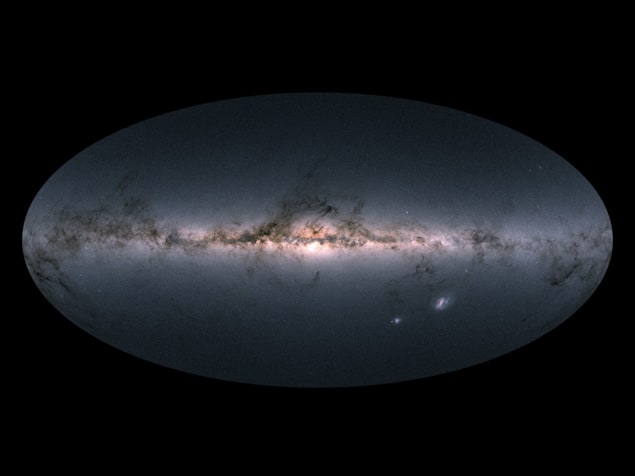
The halo of the Milky Way mainly comprises the remnants of a pre-formed structure of stars that merged into our galaxy about 10 billion years ago, researchers in France and the Netherlands have concluded. The researchers studied new data from ESA’s Gaia Space Observatory alongside spectral information from the Sloan Digital Sky Survey, and they concluded that stars from the object, which they have termed Gaia-Enceladus, are chemically and kinematically distinct from other stars that formed from dust and gas in our galaxy.
The Milky Way is a spiral galaxy comprising a disc, with a bulge at its centre, that rotates roughly in step. “The Sun and the vast majority of the stars in the galaxy tend to move in orderly, circular orbits around the centre,” explains astronomer Amina Helmi of the University of Groningen in the Netherlands, who led the new research: “The way you get stars on these orbits is to form them from gas clouds in the Milky Way itself.”
Surrounding this disc, however, is a more diffuse halo of stars with more random orbits. “From models, we knew that if galaxies had experienced mergers, then most of the stars from the object that merged would be in the halo,” explains Helmi. “But the big questions included how many stars in the Milky Way’s halo came from galaxies that merged with ours and what kinds of galaxies these were.”
The Gaia Space Observatory, run by ESA, is methodically cataloguing light sources in the night sky. Within the Milky Way, its telescopes can often resolve individual stars. The first data was released in September 2016, revealing information about the magnitude, position and motion of over 2 million stars. Incredibly, the second data release, in April 2018, increased this figure to about 1.3 billion. “That has allowed us to address so many interesting questions, and in particular to figure out how the Milky Way was assembled,” says Helmi.
The researchers looked at the orbits of individual stars in the halo. They noticed that, although they were far less regular than the orbits of stars in the disc, many of them were dynamically correlated, orbiting backwards relative to the rest of the galaxy. This implied they had come from the same source. The researchers then cross-referenced the Gaia data on the stars’ orbits with data from APOGEE-2 (Apache Point Observatory Galactic Evolution Experiment), part of the Sloan Digital Sky Survey, which had captured the spectra of the light from a sample of the stars.
From analysing their emission spectra, the researchers dicovered large variations in the elemental compositions of the dynamically correlated stars. There are, however, correlations between the abundances of specific elements that indicate the stars had formed in the same environment. “You can see chemical composition as a way of labelling a star’s place of formation,” explains Helmi. These differences between the stars’ compositions implied that they had formed at different times and were therefore at different stages in their stellar evolution.
Detailed analysis led the researchers to conclude that the stars ranged between 10 and 13 billion years in age. This implies, say the researchers, that Gaia-Enceladus formed about 13 billion years ago and formed stars continuously until about 10 billion years ago – when it collided with and merged into the Milky Way. At this point, simulations suggest the gas and dust would have been drawn out of the galaxy, preventing any further star formation: “As soon as you lose the gas you lose the fuel for forming new stars,” explains Helmi, “so the last stars to be formed in a galaxy give you a time stamp for when that galaxy was accreted.”
The researchers estimate that, at the time of accretion, Gaia-Enceladus was about 25% of the size of the Milky Way. This leaves little room in the halo for stars from other sources. “It was a big surprise to find that the vast majority of the stars in the halo today actually come from a single object,” says Helmi. The researchers suggest the energy from the collision may explain the high velocity of some stars in the disk.
Poul Erik Nissen of Aarhus University in Denmark describes the research as “important”. In 2010, he and a colleague noted the distinctive chemical features of many halo stars. “The present paper confirms the existence of such stars in the inner Galactic halo and finds evidence that they are due to the encounter of a single massive dwarf galaxy with the Milky Way,” he says. He is more circumspect about the researchers’ links between the merger and high velocity stars in the disk, saying that “further studies” are needed.
The research is published in Nature.



